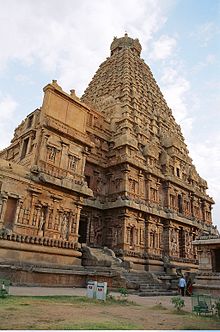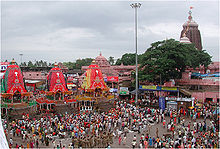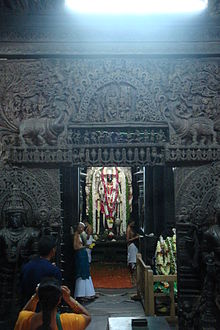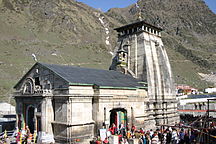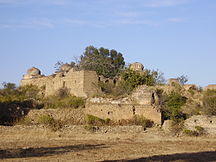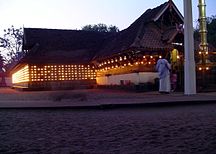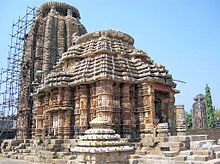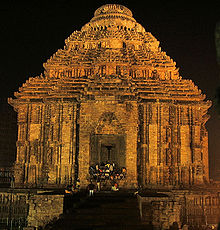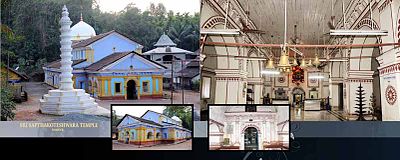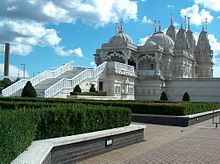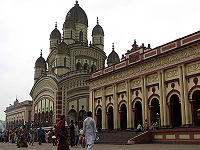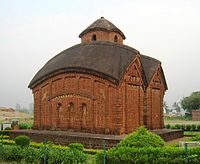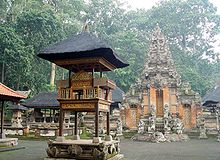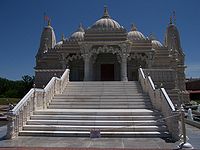- Hindu temple
-
A Mandir, Devalayam, Devasthanam, or a Hindu temple (Sanskrit: देवालयः, Tamil: கோயில் / கோவில், Telugu :దేవాలయం, Kannada: ದೇವಸ್ಥಾನ,Sinhala: කෝවිල, Hindi: मन्दिर, Gujarati: મંદિર, Konkani:दॆवळ / दॆवस्थान, Marathi: देऊळ, Oriya:ଦେଉଳ,ମଦିର, Bengali: মন্দির, Malayalam: അമ്പലം, Punjabi: ਮੰਦਰ) is a place of worship for followers of Hinduism. A characteristic of most temples is the presence of murtis (statues) of the Hindu deity to whom the temple is dedicated. They are usually dedicated to one primary deity, the presiding deity, and other deities associated with the main deity. However, some temples are dedicated to several deities, and others are dedicated to murtis in an aniconic form. Many temples are in key geographical points, such as a hill top, near waterfalls, caves and rivers, because some believe the Puranas mention that "the gods always play where groves are near rivers, mountains, and springs."[1]
Nomenclature, orthography and etymology
Many Hindu temples are known by different names around the world, depending upon the language. The word mandir or mandiram is used in many languages and is derived from a Sanskrit word, mandira, for 'house' (of a deity by implication). Temples are known as Mandir, Devasthanam, Kshetralayam, Punyakshetram, or Punyakshetralayam in Telugu, as Deula(ଦେଉଳ)/Mandira(ମଦିର) in Oriya, Devastanam in Kannada and Mondir (মন্দির) in Bengali, as Kshatriya or Jambalaya in Malayalam. Temples are known as kō-ail (கோயில்) (and occasionally, especially in modern formal speech, Aalayam (ஆலயம்) in Tamil. The etymology is from kō (கோ) or lord, and il (இல்) home. (Besides meaning a deity's home, this term could also mean a king's home, since the term kō (கோ) is used interchangeably for royalty and divinity.)
History
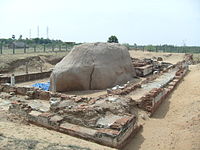 The Subrahmanya temple at Saluvankuppam, near Mahabalipuram in Tamil Nadu. The brick shrine dates to the Sangam period and is one of the oldest Hindu temples to be unearthed
The Subrahmanya temple at Saluvankuppam, near Mahabalipuram in Tamil Nadu. The brick shrine dates to the Sangam period and is one of the oldest Hindu temples to be unearthed
The oldest temples that were built of brick and wood no longer exist. Stone later became the preferred material. Temples marked the transition of Hinduism from the Vedic religion of ritual sacrifices to a religion of Bhakti or love and devotion to a personal deity.
Temple construction and mode of worship is governed by ancient Sanskrit scriptures called agamas, of which there are several, which deal with individual deities. There are substantial differences in architecture, customs, rituals and traditions in temples in different parts of India.
During the ritual consecration of a temple, the presence of the universal all-encompassing Brahman is invoked into the main stone deity of the temple, through ritual, thereby making the deity and the temple sacred and divine.
Architecture and alignment
Earth has its energy centres that correspond to universal data centres of life and awareness. The temple, through which contacts or relations are established among the states of being (humans, spirits, and gods), is thus a combination of the data of yoga, astrology, and sacred geography. In the temple structure, there are diagrams similar to the ones described for chakras according to yoga experience, with proportions similar to those deriving from the position of the stars, by which the influence can be explained. The characteristics of site and orientation are connected to the living structure of the Earth. The Hindu temple is thus not a place where the faithful may gather but a sacred building constructed to receive subtle influences.[2]
Hindu temples are generally divided into four main architectural styles: the Dravida style of South India, the Nagara style of North India, the mixed Vesara style and the Kalinga architecture (i.e. the temple style of Orissa).
Customs and etiquette
PracticesThe customs and etiquette when visiting Hindu temples have a long history and are filled with symbolism, solemn respect and veneration of Brahma's creation.
Worshipers in major temples typically bring in symbolic offerings for the prayer or 'puja'. This includes fruits, flowers, sweets and other symbols of the bounty of the natural world. Temples in India are usually surrounded by small stores called 'dukanam' (Telugu) or 'dukan' (Hindi) which offer them typically wrapped in organic containers such as banana leaves.
When inside the temple, it is typical to keep both hands folded together as a sign of respect. The inner sanctuary, where the murtis reside, is known as the garbhagruh. It symbolizes the birthplace of the universe, the meeting place of the gods and mankind, and "the threshold between the transcendental and the phenomenal worlds."[3] It is in this inner shrine that devotees offer prayers and salutations to the presiding deities. Devotees may or may not be able to personally present their offerings at the feet of the deity. In most South Indian temples, only the pujaris are allowed to enter into the garbhagruh.[4] In North Indian temples, however, it is more common for devotees to be allowed entrance.[4]
The mantras spoken are typically "Om Namo Narayana" or "Om Namah Shivaya" which mean "Obeisance to Narayana (vishnu)" or "Salutations to Shiva". These are followed by a series of shlokas or verses from the holy texts such as the Bhagavad Gita, Upanishads or Vedas. Upon the conclusion of prayer, devotees get down on their knees or even fall flat on their stomach and bow before the symbol of the deity. If a priest or 'Pujari' is present, he is likely to provide sacred symbolically blessed food called 'prasad' to the devotee. He may also apply a holy red mark called 'tilak' to the forehead of the devotee symbolising blessings.
Finally the worshiper or visitor walks clockwise around the sanctum sanctorum, stop once on each side, close their eyes and pray to the All Loving Being. The worshiper may receive a sprinkling of the water from the holy river Ganges while the 'pujari' states "Om Shanti" which means "peace be unto all".
During religious holidays, temples may be swarmed with devotees chanting and praying loudly. There may be facilitators called 'paandaas' who help visitors navigate through the crowds and complete the 'puja' or prayer rituals quickly.
Temple management staff typically announce the hours of operation, including timings for special 'pujas'. These timings, due to the vast diversity in Hinduism, vary from temple to temple. For example, some temples may perform aarti once or twice per day, while other temples, such as those part of Swaminarayan movement, may perform aarti five times per day. Additionally, there may be specially allotted times for devotees to perform circumambulations (or pradakshina) around the outside of the temple.[4] There are also timings for devotional songs or music called bhajans, which are accompanied by a dholak or tabla soloist and/or harmonium soloist. There are dates and times for devotional dances such as the classical Bharata Natyam dance performed by accomplished performers.
Visitors and worshipers to Hindu temples are required to remove shoes and other footwear before entering. Most temples have an area designated to store footwear. Additionally, it may be customary, particularly at South Indian temples, for men to remove shirts and to cover pants and shorts with a traditional cloth known as a Vasthiram.[5]
The Hindu religion teaches that all life-forms are created by Brahma and that humankind needs to share the world with the animal kingdom. It is common to see stray dogs, cows, monkeys, and birds congregated at temples.
North Indian temples
Most ordinary temples in North Indian rituals are very simple in stark contrast to South Indian temples which have elaborate rituals. Also North Indian temples often tend to be less orthodox and in many cases everybody are permitted to enter the innermost sanctum of the deity and worship the deity personally. In such cases, the deity is not adorned with valuable jewelry. The innermost heart of the temple is the sanctum where the deity (usually of fixed stone) is present, followed by a large hall for lay worshipers to stand in and obtain "darshan" or divine audience. There may or may not be many more surrounding corridors, halls etc. However there will be space for devotees to go around the temple in clock wise fashion circumambulation as a mark of respect. In North Indian temples, the tallest towers are built over the sanctum sanctorum.
One example of a type of more elaborate North Indian temple is the style of temple known as the Shikharbaddha Mandir found in Northern and Western India, and particularly famous in the Swaminarayan Hindu tradition. These temples have towers, or shikharas, built over the sanctum sanctorum, in which the deity is installed.[6]
South Indian temples
Many large bannabs (grand stone temples) still stand in South India. Ritual tends to be orthodox and elaborate especially in the large vedic brahmincal temples, which follow the pan-Indian Sanskrit agama scriptural traditions. Apart from the main fixed stone deities, processional deities made of panchaloha (an alloy of gold, silver, copper, zinc and tin) are bathed, dressed, decorated with valuables and taken out in processions for festivals throughout the year. The richer the temple, the more elaborate the festivals. However, many ancient temples in small villages with great architectural and historical heritage value languish for lack of funds for maintenance.
Famous South Indian temples are Lord Sri Venkateshwara Temple, Tirumala Tirupati temple, Andhra; Mookambi temple, Karnataka; Chennakesava temple, Belur (Karnataka); Sri Padmanabha Swamy Temple, Kerala; Sabarimala temple, Kerala; Guruvayoor temple, Kerala; Kodungallor temple, Kerala; Anikkattilammakshethram, kerala; Kanyakumari temple, Tamil Nadu (TN); Madurai Meenakshi Amman Temple, Tamil Nadu; Srirangam Ranganathar temple and Thiruvanaikaval temple of Tiruchi, TN; Golden Temple of Sripuram, TN; Brihadeshwara temple, Thanjavur, TN; oldest temples such as Kailasanathar[disambiguation needed
 ] temple, Varatharajaperumal temple, Kamakshi temple and Ekambareshwarar temple of Kanchipuram, TN; Thirukadiyur Abirami temple, TN; Andal temple, Srivilliputhur, TN; Natarajar temple, Chidambaram, TN; Kumbeshwara, Kumbakonam, TN; Thiruvannaamalai temple, Tamil Nadu; Palani temple, Tamil Nadu; Kodungallor temple, Kerala; Chettikulangara Devi temple, Kerala; Aranmula Parthasarathy temple, Kerala; Tripunithura sree Poornathrayesa, Kerala.
] temple, Varatharajaperumal temple, Kamakshi temple and Ekambareshwarar temple of Kanchipuram, TN; Thirukadiyur Abirami temple, TN; Andal temple, Srivilliputhur, TN; Natarajar temple, Chidambaram, TN; Kumbeshwara, Kumbakonam, TN; Thiruvannaamalai temple, Tamil Nadu; Palani temple, Tamil Nadu; Kodungallor temple, Kerala; Chettikulangara Devi temple, Kerala; Aranmula Parthasarathy temple, Kerala; Tripunithura sree Poornathrayesa, Kerala.Temples in Orissa
Temples often greatly vary in their appearance, rituals, traditions, festivals and customs from region to region. Temples in eastern state of Orissa and Western India also have their distinctions. In the south, Kerala temples are very different from temples in the other three states.
The most world famous temples i.e. Jagannath temple at Puri, Sun temple at Konark, Lingaraj temple at Bhubaneswar are found in Orissa. These temples are over 1200 years old. In Bhubaneswar, around 10,000 temples are present which represents strong Hindusim in Orissa.
Temples of Goa and other Konkani temples
The temple architecture of Goa is quite unique. As part of Inquisition of Goa, the Portuguese demolished more than 1000 temples on Island of Goa. New temples were later built in the areas in Goa which were not parts of Portuguese kingdom, and were under reign of Hindu princely states. Thus these temples are not more than 500 years old, and are a unique blend of original Goan temple architecture, Dravidian, Nagar and Hemadpanti temple styles with some Islamic and Portuguese architectural influences.Goan temples were built using sedimentary rocks,wood,limestone and clay tiles as well as copper sheets were used for the roofs.These temples were decorated with mural art called as Kavi kala or ocher art.The interiors were decorated with such murals as well as exquisite wood carvings depicting scenes from the Hindu mythology.
Hindu Temples outside South Asia
Many members of the South Asian diaspora have established Hindu mandirs outside India as a means of preserving and celebrating cultural and spiritual heritage abroad. Describing the hundreds of mandirs that can be found throughout the United States, scholar Gail M. Harley observes, “The temples serve as central locations where Hindus can come together to worship during holy festivals and socialize with other Hindus. Temples in America reflect the colorful kaleidoscopic aspects contained in Hinduism while unifying people who are disbursed throughout the American landscape.”[7]
Numerous mandirs in North America and Europe have gained particular prominence and acclaim. The Sri Sri Radha Krishna Temple in Utah, for example, attracts thousands of visitors each year for a variety of cultural and religious events. The B.A.P.S. organization has built over sixty mandirs in North America, as well as numerous temples in Europe. The BAPS Shri Swaminarayan Mandir London, for example, has been recognized by the Guinness Book of World Records as the largest traditional Hindu temple outside India, and has been constructed according to Vedic architectural standards.[8] The temples constructed in this traditional style of temple architecture are known as Shikharbaddha Mandirs.[9] Another example of a Swaminarayan Shikharbaddha Mandir is the BAPS Shri Swaminarayan Mandir Toronto, which is the largest Hindu temple in Canada.
Temples in West Bengal and Bangaladesh
In West Bengal and Bangaladesh, temple architecture has assumed a unique identity and evolved into the Bengali terra cotta temple architecture. Due to lack of suitable stone in the alluvial Gangetic delta, the temple makers had to resort to other materials instead of stone. This gave rise to using terra cotta as a medium for temple construction. Terra-cotta exteriors with rich carvings are a unique feature of Bengali temples. The town of Vishnupur in West Bengal is renowned for this type of architecture.
Usually a part of the intended total motif was carved by hand on one side of a brick and then baked. While under construction, these carved bricks were arranged to make up the entire motif.
The Bengali style of temple is not luxurious. Rather, most are modeled on simple thatched-roof earthen huts used as dwellings by commoners. This can be attributed to the popularity of bhakti cults which taught people to view gods as close to themselves. Thus, various styles like do-chala, char-chala, and aat-chala sprang up. However, there is also a popular style of building known as Navaratna (nine-towered) or Pancharatna (five-towered) in Bengal which is more luxurious than the Chala buildings. A typical example of Navaratna style is the Dakshineswar Kali Temple.
Temples in Indonesia
Hindu temples of ancient Java, Indonesia, bear resemblances with temples of South Indian style. However later ancient Javanese art and architecture developed its own style. The fine example of 9th century Javanese Hindu temple is the towering Trimurti temple of Prambanan in Yogyakarta. In Bali, unlike the common towering indoor Indian Hindu temple, Pura (Balinese temple) is designed as an open-air worship place within enclosed walls, connected with series of intricately decorated gates to reach its compounds. The design, plan and layout of the holy pura is followed the "Trimandala" concept, three mandala zone arranged according to the hierarchy of its sacredness.
Temple Management and erosion of Autonomy by control of states and Law
The Archeological Survey of India has control of most ancient temples of archaeological importance in India.
In India, theoretically, a temple is managed by a temple board committee that administers its finances, management and events.
However since independence, the autonomy of individual Hindu religious denominations to manage their own affairs with respect to temples of their own denomination have been severely eroded. State governments of many states in India (and especially all the states in South India) have gradually increased their control over all Hindu temples. Over decades, by enacting various laws which have been fought both successfully and unsuccessfully up to the Supreme court of India, politicians of the ruling parties especially in the southern states control every aspect of temple management and functioning.
See also
References
- ^ Robinson, James. Religions of the World: Hinduism. 1st. Chelsea House Publishers, 2004. Page 72.
- ^ The Hindu Temple. Alain Danielou.
- ^ Werner, Karel (1994). A Popular Dictionary of Hinduism. Curzon Press. ISBN 0-7007-1049-3.
- ^ a b c Narayanan,Vasudha. "The Hindu Tradition". In A Concise Introduction to World Religions, ed. Willard G. Oxtoby and Alan F. Segal. New York: Oxford University Press, 2007
- ^ Bain, Keith, Pippa Bryun, and David Allardice. Frommer’s India. 1st. New Jersey: Wiley Publishing, 2010. Page 75
- ^ Williams, Raymond (2001). Introduction to Swaminarayan Hinduism. Cambridge University Press. pp. 123–136. ISBN 9780521654227. http://books.google.com/?id=tPkexi2EhAIC&printsec=frontcover.
- ^ Harley, Gail M (2003). Hindu and Sikh Faiths in America. Facts on File, Inc. ISBN 0-8160-4987-4.
- ^ BAPS Swaminarayan Sanstha, UK – Awards – BAPS Shri Swaminarayan Mandir, London. Mandir.org. Retrieved on 2011-11-10.
- ^ Kim, Hanna (2009). "Public Engagement and Personal Desires: Baps Swaminarayan Temples and Their Contribution to the Discourses on Religion". International Journal of Hindu Studies 13 (3): 370.
Categories:- Hindu temples
- Hindu temple architecture
Wikimedia Foundation. 2010.

